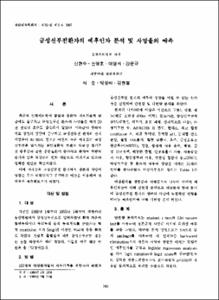KUMEL Repository
1. Journal Papers (연구논문)
1. School of Medicine (의과대학)
Dept. of Internal Medicine (내과학)
급성신부전환자의 예후인자 분석 및 사망율의 예측
- Alternative Author(s)
- Park, Sung Bae; Kim, Hyun Chul
- Journal Title
- 대한내과학회지
- ISSN
- 1226-329x
- Issued Date
- 1997
- Abstract
- Objectives: Over the last 30 years, despite the increasing sophistication in medical care, the mortality of acute renal failure(ARF) has remained virtually unchanged at 40-50%, but the reasons remain unknown.
This study intend to identify prognostic risk factors influencing survival and predict the mortality in ARF patients.
Methods '■ We retrospectively analyzed 152 patients with ARF who required renal replacement therapy, or whose serum creatinine level above 5 mg/dl, from Jan. 1988 to May. 1995. Multiple factors which may influence mortality were evaluated by univariate and multivariate analysis.
Results:
1) Of the 152 patients, 97 were male and 55 were female. The mean age was 47 years and the overall mortality was 36.8%.
2) Based on the univariate analysis, age>60 years, cause of ARF, APACHE II score, number of failing organs, peak serum creatinine level, PaO2, coma, hypotension, ARDS, GI bleeding, ventilatory support, need for antiarrhythmics, DIG, cardiovascular failure, pulmonary failure, neurological failure, and gastrointestinal failure were all significant factors discriminating between survivors and nonsurvivors(p<0.05)
3) By multivariate analysis, hypotension, coma, ventilatory support, and age over 60 years were significant independent predictors influencing sur-
vival in ARF patients and logistic equation and logit score were as follows :
z=~2.04+1.32(age over 60)+2.18(hypotension)+2.88 (ventilatory support) + 3.28(coma) P=ez/(1 +ez)
4) In ROC(receiver-operating characteristic)curve, when the cutoff point was 0.2, maximum sensitivity was 75% and maximum specificity was 82%.
Conculusion • In ARF, prognostic risk factors for mortality were age over 60 years, hypotension, assisted ventilation and coma. The logit score by multiple analysis is a reliable predictor of mortality in ARF patients, however the further studies are required to confirm these results.
Key Words : ARF, Prognostic factors, Mortality
지난 수 십년간 신 대체요법의 발달과 내과적 치료 기술의 발달에 불구하고 급성신부전 환자의 사망율은 아직도 40-50% 이상으로 높은 실정이다. 환자의 예 후에 영향올 미치는 인자들도 매우 다양하여 아직 예후를 예측할 수 있는 정확한 임상지표가 확립되어 있지않다.이에 저자들은 1988년 1월부터 1995년 5월까 지 계명의대 동산병원에서 급성신부전으로 입원 하였 던 152명을 대상으로 예후에 영향올 미칠수 있는 31개의 변수들을 후향조사하여단변량 분석과 다변량 분 석으로 예후인자 분석 및 logit score롤 구하여 급성 신부전 환자의 예후를 예측 하였다.
1) 대상환자는 총 152명중 남자가 97명(64%), 여 자가55명(36%)이었고, 평균 나이는 47土17세였으며, 전체 사망율은 36.8% 였다.
2) 단변량 분석으로는 60세 이상의 나이,원인질환, APACHE Ⅱ 점수, 다장기부전수, 혈청 최고creatinine 치,PaO2,혼수, 저혈압, ARDS,위장관 출혈, 인공 호흡기 사용, 부정맥, 다장기부전중 심혈관 계 부전, 호홉 부전, 신경학적 장애, 위장관기능 부전 둥의 변수들은 생존군과 사망군간에 유의한 차이가 있 었다(p<0.05).
3) 다변량 분석으로는 인자중 혼수, 저혈압, 인공호 홉기사용, 60세 이상의 나이 등 4개의 인자들만이 급 성신부전 환자에서 생존과 사망에 영향올 미치는 독립 적인 예후인자였고 이들올 이용하여 logit score롤 구하였다.
4) Logistic regression analysis로 구한 식과 logit score는 다음과 같다.
z=2.04 +1.32(60〉나이)+2.18(저혈압) +2.88( 인공호홉기 사용)+3.28(혼수) P=ez/(1 +ez)
5〉Logit score에의한 ROC(receiver-operating characteristic)곡선에서 판별 기준점올 0.2로 잡았올 때 민감도는 75%,특이도는 82%였다.
- Alternative Title
- Analysis of Risk Factors and Prediction of Mortality in Acute Renal Failure
- Department
- Dept. of Internal Medicine (내과학)
- Publisher
- School of Medicine
- Citation
- 신현수 et al. (1997). 급성신부전환자의 예후인자 분석 및 사망율의 예측. 대한내과학회지, 53(2), 160–168.
- Type
- Article
- ISSN
- 1226-329x
- Appears in Collections:
- 1. School of Medicine (의과대학) > Dept. of Internal Medicine (내과학)
- 파일 목록
-
-
Download
 oak-bbb-00688.pdf
기타 데이터 / 579.19 kB / Adobe PDF
oak-bbb-00688.pdf
기타 데이터 / 579.19 kB / Adobe PDF
-
Items in Repository are protected by copyright, with all rights reserved, unless otherwise indicated.